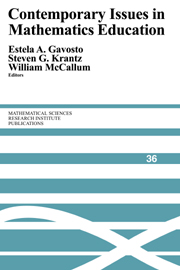Book contents
On the Role of Proof in Calculus Courses
Published online by Cambridge University Press: 27 June 2025
Summary
I would like to consider two questions:
• Should students see proofs in a standard calculus course?
• Should students do proofs in a standard calculus course?
I use the word “should” with all its moral overtones because I think that to many this is as much a moral issue as a pedagogical one. On the other hand, I have a hard time distinguishing moral considerations from considerations of taste, where the dictum de gustibus non est disputandum applies. Therefore I will for the most part think of “should” as “need” or “must” or even “does it help”. I do believe these questions are at the root of some of the debate about calculus reform, but I have heard very little thoughtful discussion of the issue. I must, however, apologize that what I say is woefully uninformed by research in mathematical education, and all I intend is to begin a dialogue.
Before I proceed I would like to differentiate between two pedagogical uses of proof. The first, which I'll call Proof I, is part of a process of formalization and organization. In this setting, the student is presumed to have an effective, reliable understanding of concepts and results; the goal is to develop a formal language with which those results can be proved true. I would consider the proof that the limit of a sum is the sum of the limits as Proof I. The second sort of proof, which I'll call Proof II, is less formal, and is used to answer a question that is in doubt.
Information
- Type
- Chapter
- Information
- Contemporary Issues in Mathematics Education , pp. 31 - 36Publisher: Cambridge University PressPrint publication year: 1999
Accessibility standard: Unknown
Why this information is here
This section outlines the accessibility features of this content - including support for screen readers, full keyboard navigation and high-contrast display options. This may not be relevant for you.Accessibility Information
- 1
- Cited by
